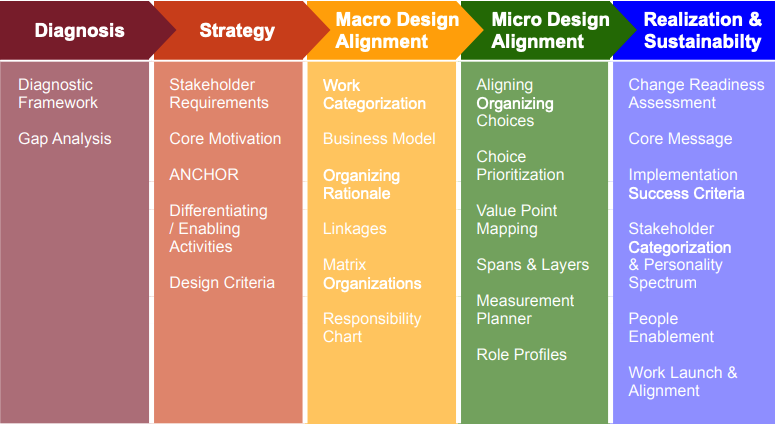Organization redesigns are often complex, challenging, and lengthy endeavors that require considerable resources to produce the desired results. We’ve talked about the importance of mapping your route to success and forming a team of skilled people ready to work toward a common goal. The next step is to develop the framework and tools to ensure steady progress and prevent the work from dissolving into a series of directionless conversations. The right framework– supported by the right tools and knowledgeable change partners who know how to best use those tools – is critical to achieving a successful transformation.
You can have a ridiculously enormous and complex data set, but if you have the right tools and methodology, then it’s not a problem. – Data Visualization Artist Aaron Koblin
A Framework for Transformation Success
When it is time to initiate a redesign, everyone wants the confidence that comes with combining a cutting-edge approach with a solid track record. We use a methodology that is built around five specific phases:
- Diagnosing the current state of the organization and identifying the desired state
- Clarifying strategy
- Designing the organization from a macro level
- Aligning the micro level with the macro design
- Implementing the changes
By following this framework, leaders can make sure every level of the organization becomes aligned with their new strategic goals. Alignment Leaders® and change partners can use this methodology to help teams make the best operational and strategic choices to move the organization forward.
Assembling Your Tool Kit
Combining a proven approach with the right tool kit guides teams while helping them identify and address design questions that arise during the transformation journey. For example, one client in Australia was lingering in third place behind two larger players. They examined their market and realized that customers were asking for better and simpler customer service. As we worked with them using a number of the alignment tools, they developed an organizational construct that allowed them to jump ahead of their competition in customer service. Alignment Leaders determined the strategy; the design team clarified what that strategy would mean for the rest of the organization by articulating new and redesigned design choices. Customers appreciated the refocus, and the organization appreciated having a thoughtful response to the strategic opportunities and challenges in front of them.
It is essential to have good tools, but it is also essential that the tools should be used in the right way. – Author Wallace D. Wattles
Each phase of the transformation process calls for specific organization design alignment tools to address particular design questions and issues within that phase. Here, you can see many of the tools we use and where they fall in each step of the organization transformation process:

Each of the tools has a specific purpose and is designed to answer a key design question, such as:
- What organizational capabilities will help drive strategy?
- Where should work be placed in an organization?
- How will organization boundaries be spanned?
As you create your toolbox, consider what tools will help you best analyze, evaluate and make organization choices. You’ll want tools to help you analyze current results and gaps to better understand what your organization is capable of delivering. You’ll also need tools to help you understand the implications of your organization’s strategy, as well as tools that solve tactical concerns like how to transform operations to improve performance and drive behavior change.
The right tools will give you an overall approach, a model, and a set of instruments needed to move forward towards your organization’s transformational goals. They will also help Alignment Leaders envision team members’ path to progress during each phase of the organization redesign project.
